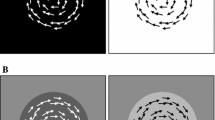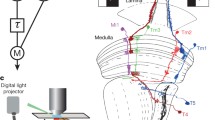Summary
Visual movement detection has been investigated both under photopic and scotopic light conditions by measuring the optomotor turning responses of walking flies,Musca domestica. From the data it is concluded that the spatial sampling pattern underlying movement detection changes with the average stimulus brightness. At high luminance nearest-neighbour interactions clearly dominate whereas at very low light intensities interactions between receptors having one, two and three times the minimum angular separation contribute with about equal strength to the response (Figs. 6, 7). This change in the spatial interaction pattern may be based on neuronal recruitment of wide-angle movement detectors at low light levels or, alternatively, on neural pooling of signals from neighbouring receptors prior to the movement-specific interactions. Both mechanisms may provide a gain in absolute light sensitivity at the cost of spatial acuity.
The temporal properties of movement detection also change with stimulus brightness. High grating speeds are detected less efficiently at low luminance (Fig. 3). These temporal changes may be attributed to equivalent changes in the photoreceptor responses.
Negative optomotor responses may be elicited by a pair of test stimuli separated in visual angle by about 15° corresponding to 7–8 rows of ommatidia (Figs. 9, 10). This unexpected behaviour is suggested to reflect the influence of lateral inhibition which extends, in the periphery of the visual system, with decreasing strength over a range of at least 5 rows of ommatidia. Movement-specific interactions on the other hand do not appear to extend beyond 4–5 rows of ommatidia.
Similar content being viewed by others
Abbreviations
- R1-6 :
-
the six peripheral receptors in a fly's ommatidium
- R7/8 :
-
the two central receptors in a fly's ommatidium
- Δρ :
-
half width of angular sensitivity function
- Δϑ * :
-
angle between optical axes of neighbouring rows of ommatidia (√3/2 interommatidial angle)
- λ :
-
spatial wavelength of periodic grating
- m rec :
-
light modulation in a receptor
References
Barlow, H.B.: Dark and light adaptation: psychophysics. In: Handbook of sensory physiology, Vol. VII/4. Visual psychophysics. Jameson, D., Hurvich, L.M. (eds.), pp. 1–28. Berlin, Heidelberg, New York: Springer 1972
Buchner, E.: Elementary movement detectors in an insect visual system. Biol. Cybernetics24, 85–101 (1976)
Buchner, E., Götz, K.G., Sträub, C.: Elementary detectors for vertical movement in the visual system ofDrosophila. Biol. Cybernetics31, 235–242 (1978)
Collett, T.S., Land, M.F.: How hoverflies compute interception courses. J. Comp. Physiol.125, 191–204 (1978)
Dvorak, D., Snyder, A.: The relationship between visual acuity and illumination in the fly,Lucilia sericata. Z. Naturforsch.33c, 139–143 (1978)
Eckert, H.: Die spektrale Empfindlichkeit des Komplexauges vonMusca. Kybernetik9, 145–156 (1971)
Eckert, H.: Optomotorische Untersuchungen am visuellen System der StubenfliegeMusca domestica L. Kybernetik14, 1–23 (1973)
Fermi, G., Reichardt, W.: Optomotorische Reaktionen der FliegeMusca domestica. Kybernetik2, 15–28 (1963)
Götz, K.G.: Optomotorische Untersuchungen des visuellen Systems einiger Augenmutanten der FruchtfliegeDrosophila. Kybernetik2, 77–92 (1964)
Hardie, R.C.: Electrophysiological analysis of fly retina. I: Comparative properties of R1-6 and R7 and 8. J. Comp. Physiol.129, 19–33 (1979)
Hassenstein, B.: Ommatidienraster und afferente Bewegungsintegration. Z. Vergl. Physiol.33, 301–326 (1951)
Hassenstein, B.: Über die Wahrnehmung der Bewegung von Figuren und unregelmäßigen Helligkeitsmustern. Z. Vergl. Physiol.40, 556–592 (1958)
Heisenberg, M., Götz, K.G.: The use of mutations for the partial degradation of vision inDrosophila melanogaster. J. Comp. Physiol.98, 217–241 (1975)
Heisenberg, M., Buchner, E.: The role of retinula cell types in visual behavior ofDrosophila melanogaster. J. Comp. Physiol.117, 127–162 (1977)
Kirschfeld, K.: Die Projektion der optischen Umwelt auf das Raster der Rhabdomere im Komplexauge vonMusca. Exp. Brain Res.3, 248–270 (1967)
Kirschfeld, K.: The visual system ofMusca: Studies on optics, structure and function. In: Information processing in the visual system of arthropods. Wehner, R. (ed.), pp. 61–74, Berlin, Heidelberg, New York: Springer 1972
Kirschfeld, K., Franceschini, N.: Optische Eigenschaften der Ommatidien im Komplexauge vonMusca. Kybernetik5, 47–52 (1968)
Kirschfeld, K., Lutz, B.: Lateral inhibition in the compound eye of the flyMusca. Z. Naturforsch.29c, 95–97 (1974)
Land, M.F., Collett, T.S.: Chasing behaviour of houseflies (Fannia canicularis). J. Comp. Physiol.89, 331–357 (1974)
Laughlin, S.B., Hardie, R.C.: Common strategies for light adaptation in the peripheral visual systems of fly and dragonfly. J. Comp. Physiol.128, 319–340 (1978)
Mimura, K.: Some spatial properties in the first optic ganglion of the fly. J. Comp. Physiol.105, 65–82 (1976)
Pick, B.: Visual flicker induces orientation behavior in the flyMusca. Z. Naturforsch.29c, 310–312 (1974)
Pick, B.: Specific misalignments of rhabdomere visual axes in the neural superposition eye of dipteran flies. Biol. Cybernetics26, 215–224 (1977)
Poggio, T., Reichardt, W.: Considerations on models of movement detection. Kybernetik13, 223–227 (1973)
Reichardt, W., Poggio, T.: Visual control of orientation behaviour of the fly. Q. Rev. Biophys.9, (3), 311–438 (1976)
Scholes, J.: The electrical responses of the retinal receptors and the lamina in the visual system of the flyMusca. Kybernetik6, 149–162 (1969)
Smola, U.: Voltage noise in insect visual cells. In: Neural principles in vision. Zettler, F., Weiler, R. (eds.), pp. 194–213. Berlin, Heidelberg, New York: Springer 1976
Snyder, A.W.: Acuity of compound eyes: physical limitations and design. J. Comp. Physiol.116, 161–182 (1977)
Zettler, F.: Die Abhängigkeit des Übertragungsverhaltens von Frequenz und Adaptationszustand; gemessen am einzelnen Lichtrezeptor vonCalliphora erythrocephala. Z. Vergl. Physiol.64, 432–499 (1969)
Zettler, F., Weiler, R.: Neuronal processing in the first optic neuropile of the compound eye of the fly. In: Neural principles in vision. Zettler, F., Weiler, R. (eds.), pp. 227–237. Berlin, Heidelberg, New York: Springer 1976
Author information
Authors and Affiliations
Additional information
Shortly before completion of the manuscript Dr. Bernward Pick died unexpectedly at the age of 34. We who knew him were deeply shocked by his death
We wish to thank H. Bülthoff, Drs. N. Franceschini, K.G. Götz, R. Hardie, K. Kirschfeld, T. Poggio, W. Reichardt and C. Wehrhahn for critically reading and discussing the manuscript. We are obliged to Miss C. Straub and M. Heusel for preparing the figures.
Rights and permissions
About this article
Cite this article
Pick, B., Buchner, E. Visual movement detection under light- and dark-adaptation in the fly,Musca domestica . J. Comp. Physiol. 134, 45–54 (1979). https://doi.org/10.1007/BF00610276
Accepted:
Issue Date:
DOI: https://doi.org/10.1007/BF00610276




